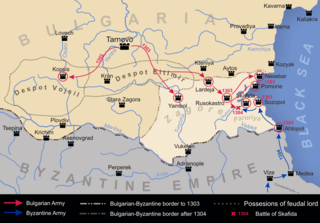 W
WAldimir or Eltimir (Елтимир) was a Bulgarian noble of the 13th–14th century. A member of the Terter dynasty and a younger brother of Tsar George I Terter, Aldimir was an influential local ruler as the despot of Kran. Aldimir rose to that position under his brother George, though as Smilets assumed the throne he was forced into exile. At the turn of the 14th century, Aldimir returned to Bulgaria as an ally of the regent widowed consort Smiltsena. He did not oppose the accession of his nephew Theodore Svetoslav and even assisted him in ousting his contenders. However, he was promptly eliminated by Theodore Svetoslav when he betrayed him to ally with the Byzantines.
 W
WAlexius Slav was a Bulgarian nobleman (bolyarin), a member of the Bulgarian Asen dynasty, a nephew of the first three Asen brothers. He was first probably the governor of the Rhodopes domain of the Second Bulgarian Empire, and then an autocrat in these lands.
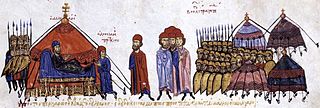 W
WAlusian was a Bulgarian and Byzantine noble who ruled as emperor (tsar) of Bulgaria for a short time in 1041.
 W
WDobromir, known to the Byzantines as Chrysos, was a leader of the Vlachs and Bulgarians in eastern Macedonia during the reign of the Byzantine emperor Alexios III Angelos. According to Niketas Choniates, Dobromir-Chrysus was, despite his Slavic name, a Vlach by birth. However, most probably he was of mixed Slavic - Vlach origins. Due to the complexity of pre-nationalist ethnic labels, references to modern ethnic groups in the Middle ages are obscure. He became prominent in 1197 and is last heard of in 1202.
 W
WDarman and Kudelin (Куделин) were two Bulgarian nobles who jointly ruled the region of Braničevo as independent or semi-independent autocrats in the late 13th century (1273–1291). Regarded by historians to be "probably Bulgarians of Cuman origin", the two brothers used the weakened state of centralized administration in the region to become independent from the Second Bulgarian Empire or the Kingdom of Hungary in 1273. The capital of their domains was the fortress of Zhdrelo, on the Mlava river. Relying on their army that consisted of people of various ethnicities, but mostly Vlachs, Serbians, Bulgarians, Tatars and Cumans, the brothers were "very independent-minded and afraid of no one".
 W
WDavid was a Bulgarian noble, brother of Emperor Samuel and eldest son of komes Nicholas, member of the Cometopuli dynasty. After the disastrous invasion of Rus' armies and the fall of North-eastern Bulgaria under Byzantine occupation in 971, he and his three younger brothers took the lead of the defence of the country. They executed their power together and each of them governed and defended a separate region. He ruled the southernmost parts of the realm from Prespa and Kastoria and was responsible for the defence the dangerous borders with Thessalonica and Thessaly. In 976 he participated in the major assault against the Byzantine Empire but was killed by vagrant Vlachs between Prespa and Kostur.
 W
WDobrotitsa was a Bulgarian noble, ruler of the de facto independent Principality of Karvuna and the Kaliakra fortress from 1354 to 1379–1386.
 W
WFruzhin was a 15th-century Bulgarian noble who fought actively against the Ottoman conquest of the Second Bulgarian Empire. A son of one of the last Bulgarian tsars, Ivan Shishman of the Tarnovo Tsardom, Fruzhin co-organized the so-called Uprising of Konstantin and Fruzhin along with Constantine II of Vidin, the last Bulgarian monarchs. Fruzhin was mainly based in the Kingdom of Hungary, where he was the ruler of Temes County.
 W
WGlad was the ruler of Banat at the time of the Hungarian conquest of the Carpathian Basin around 900 AD, according to the Gesta Hungarorum. The Gesta, which was written by an author known in modern scholarship as Anonymus in the second half of the 12th century or in the early 13th century, is the earliest extant Hungarian chronicle. The Gesta did not refer to the enemies of the conquering Hungarians, who had been mentioned in earlier annals and chronicles, but wrote of a dozen persons, including Glad, who are unknown from other primary sources of the Hungarian Conquest. Therefore, modern historians debate whether Glad was an actual enemy of the conquerors or only a "fictitious person" made up by Anonymus. In Romanian historiography, Glad is described as one of the three Romanian dukes who ruled a historical region of present-day Romania in the early 10th century.
 W
WIvan Asen, also known as Ivan Asen IV was a Bulgarian Prince, third son of Emperor Ivan Alexander from his first wife Theodora of Wallachia. He was born c. 1326.
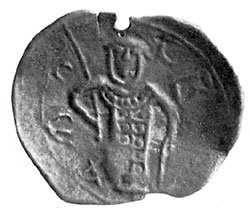 W
WJacob Svetoslav was a prominent 13th-century Bulgarian noble (bolyarin) of princely Russian origin. Bestowed the title of despot, Jacob Svetoslav was the ruler of a widely autonomous domain of the Second Bulgarian Empire most likely located around Sofia. Seeking further independence and claiming the title of Emperor of Bulgaria, he twice changed allegiance from Bulgaria to the Kingdom of Hungary and vice versa, and the Hungarians recognized his Bulgarian royal rank as their vassal and ruler of Vidin.
 W
WKrakra of Pernik, also known as Krakra Voevoda or simply Krakra, was an 11th-century feudal lord in the First Bulgarian Empire whose domain encompassed 36 fortresses in what is today southwestern Bulgaria, with his capital at Pernik. He is known for heroically resisting Byzantine sieges on multiple occasions as the Byzantines overran the Bulgarian Empire.
 W
WMichail Asen was the eldest son of Ivan Alexander of Bulgaria from his marriage with Theodora of Wallachia.
 W
WMostich was a high-ranking official in the 10th-century First Bulgarian Empire, during the rule of Simeon I and Peter I. He bore the title of Ichirgu-boil and was most likely the commander of the state capital Preslav's garrison.
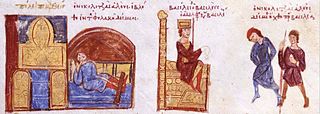 W
WNikulitsa was a Bulgarian noble from Larissa, governor of Servia during the reign of Samuil. He received his name because of his short height. In 1001 the Byzantines led by Basil II besieged the city and after a long siege they managed to break through despite the garrison's desperate defence. To secure the fortress, the entire Bulgarian population deported in the area called Boleron between the rivers Nestos and Hebros (Maritsa).
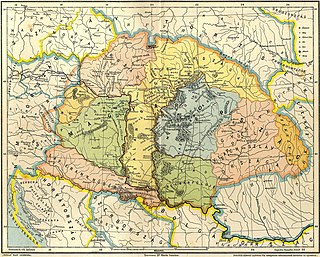 W
WSalan, Dux Salanus or Zalan was, according to the Gesta Hungarorum, a local Bulgarian voivod (duke) who ruled in the 9th century between Danube and Tisa rivers in the south and Carpathians in the north. The capital of his voivodship (duchy) was Titel. The exact border of his duchy is not clear: according to some sources, his duchy included present-day northern Serbia, much of present-day central Hungary, present-day eastern Slovakia and part of present-day western Ukraine and northern Romania, while according to other sources his duchy included only present-day Bačka region of Serbia and Hungary.
 W
WSermon was an early 11th-century voivode (duke) of Syrmia and a local governor in the First Bulgarian Empire, vassal of Bulgarian emperor Samuil. His residence was in Sirmium. He was described in Byzantine sources as: "ruler of Syrmia and brother of Nestongos".
 W
WShishman was a Bulgarian nobleman (boyar) who ruled a semi-independent realm based out of the Danubian fortress of Vidin in the late 13th and early 14th century. Shishman, who was bestowed the title of "despot" by Bulgarian emperor George Terter I, was a Cuman, and may have been established as lord of Vidin as early as the 1270s.
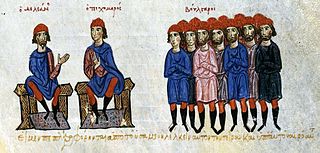 W
WTihomir was an 11th-century Bulgarian military commander of Dyrrhachium, who had been sent to tackle an uprising in the north headed by the Bulgarian noble Peter Delyan. He defected and joined him, but later came into conflict with Delyan because he had his own claim to the throne.